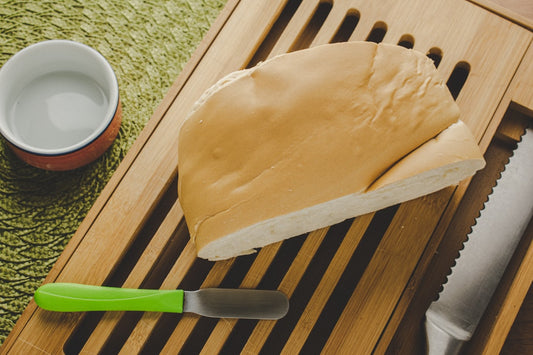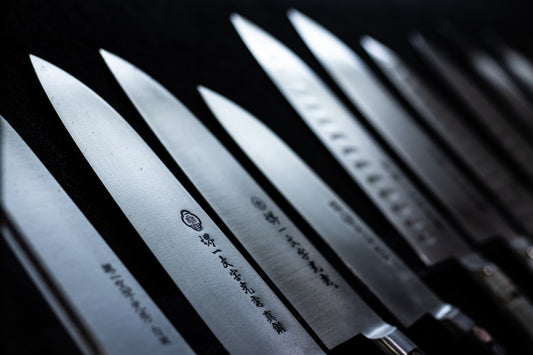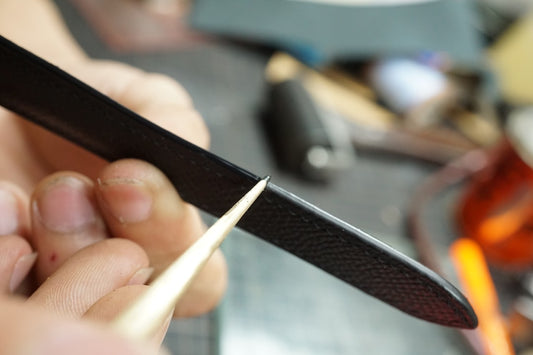
Share
Gyuto vs Santoku – Discovering the Art & Craft of Japanese Knives
Estimated Reading Time: 19 minutes
Key Takeaways
- The gyuto is a longer, versatile knife inspired by Western chef’s knives, prized for precision and power.
- The santoku is a compact, balanced “three virtues” knife ideal for home cooks focusing on vegetables, fish, and meat.
- Both knives embody traditional Japanese craftsmanship and use premium Japanese steels demanding careful maintenance.
- Blade shape, length, and balance influence cutting technique: gyuto favors rocking, santoku favors push cuts.
- Choosing between gyuto and santoku depends on cooking style, kitchen space, and personal preference for control and versatility.

Gyuto: Precision and Power in One Blade
Gyuto Knife Definition & Origin
- Gyuto (牛刀) translates directly to “cow sword.” This name reflects its origins in Meiji-era Japan, when Western cuisine and its emphasis on meat entered the Japanese culinary scene.
- Adapted from the Western chef’s knife, the gyuto knife evolved to handle a broader range of preparation. It borrows the utilitarian form of its Western ancestor but is reimagined through Japanese craftsmanship—resulting in a blade that is both versatile and singularly precise.
Blade Characteristics of the Gyuto Knife
- Length: Typically 210mm–240mm (8–9.5 inches). The gyuto is longer than the santoku knife, ideal for covering substantial cuts or large quantities.
- Profile: The blade is slender yet strong—with a belly that curves gently from heel to tip. This curvature encourages a smooth, rocking chop, allowing for both assertive strokes and delicate slicing.
- Tip: The pointed, fine tip of the gyuto knife makes it perfect for intricate work—whether you’re peeling, scoring, or carving detailed garnishes.
- Material: Forged with high-carbon Japanese steel, such as VG-10 or Aogami Blue Steel—renowned for creating a razor-sharp edge that endures. Japanese steel’s fine grain structure means the blade can be ground thinner and sharper than many Western counterparts. Learn more about the unique qualities of Japanese steel in our Ultimate Guide to Damascus Steel Japanese Knives: Authenticity, Steel Comparison, and Craftsmanship.
- Weight & Feel: Typically lighter than Western chef’s knives, the gyuto offers speed and agility, yet retains enough heft for confident control.
Ideal Uses for a Gyuto Knife
- Meat & Fish: Seamlessly slices through proteins—perfect for portioning steaks, filleting large fish, or carving roasts.
- Vegetables: Excels in chopping, mincing, and julienning. The curved edge supports continuous, efficient motion across the board. For detailed slicing techniques, see Mastering Proper Slicing Technique with Gyuto: Your Guide to Essential Knife Skills.
- Herbs & Garnishes: Fine work at the tip makes the gyuto ideal for chiffonade, decorative cuts, and intricate trimming.
- All-Purpose: In both professional and home kitchens, the gyuto’s versatility makes it the go-to kitchen knife for cooks who value adaptability and precision across multiple tasks.
Japanese Craftsmanship: The Art Behind the Gyuto
- Forging Traditions: Many high-end gyuto knives are made using principles that echo the methods of swordsmiths. Hand-forging (like honyaki or kasumi styles) and multi-layered Damascus patterns intertwine function with beauty. Delve deeper into forging processes in our Japanese Knife Forging Process: An In-Depth Guide to Tradition, Craftsmanship, and Techniques.
- Balance & Harmony: Every gyuto is meticulously weighted to create a seamless extension of the chef’s hand. The result: a sense of unity between tool and user, inspiring confidence with every cut.
- Cultural Legacy: “The gyuto is a chef’s trusted extension — precise, weighted, and responsive in every motion.” It honors the past through technique, yet remains forward-looking in design and daily purpose.
The gyuto knife captures both the power of a blade forged in the tradition of Japanese knives and the practicality needed for today’s kitchens. Its form is not accidental; it is disciplined, designed, and ready to empower mastery.
Santoku: The Home Cook’s Harmonious Companion
Santoku Knife Definition & Origin
- Santoku (三徳包丁): Its name means “Three Virtues” or “Three Uses.” This trinity points to the santoku knife’s brilliance in slicing meat, chopping vegetables, and mincing fish—capturing the essence of Japanese home cooking.
- Developed in post-war Japan, the santoku addressed a need for practical, do-it-all tools. Households were changing, and with them, the kitchen knife had to change—simplifying form without sacrificing the legacy of Japanese craftsmanship.
Blade Characteristics of the Santoku Knife
- Length: Generally shorter than the gyuto, the average santoku measures 165mm–180mm (6.5–7 inches). Its compact size makes it well-suited to the smaller kitchens found in Japanese homes, and to hands of all sizes.
- Blade Profile: The edge is flatter, with just a hint of curve near the tip. This makes the whole blade connect with the cutting board during push cuts and chopping—favoring a forward-and-down motion rather than the rocking style of the gyuto.
- Tip: The “sheep’s foot” tip is softly rounded, providing safety and increased control, especially for cooks who seek predictability and confidence at the board.
- Balance: With a balance point near the center, the santoku feels “settled” and stable in the palm. This reduces fatigue and helps maintain accuracy over repetitive prep.
- Material: Forged from the same revered Japanese steel—often stainless variants like VG-10—delivering edge retention, ease of sharpening, and a lustrous aesthetic.
Ideal Uses for a Santoku Knife
- Vegetable Prep: The santoku’s design excels at dicing, slicing, and chopping all manner of produce—from onions to daikon. Full blade-contact ensures clean, even cuts.
- Boneless Proteins: Quickly and smoothly slices chicken breast, fish fillets, and more—a true generalist across the spectrum of home cooking.
- Everyday Agility: Lightweight and easy to maneuver, the santoku invites rhythmic, intuitive prep for cooks of all experience levels.
- For detailed vegetable technique with the santoku, explore How to Julienne Vegetables with Santoku: Mastering Essential Japanese Knife Skills.
Japanese Craftsmanship: The Ingenuity of the Santoku
- Post-War Evolution: The santoku knife is a post-WWII innovation—demonstrating how necessity can shape artistry. Families sought tools that simplified daily tasks without losing the refinement or spirit of Japanese knives.
- Steel and Skill: Despite its approachable design, the santoku retains the soul of Japanese steel—a blend of hardness, edge retention, and sharpenability that encourages years of service.
- Daily Ritual: “The Santoku is harmony in motion—dependable, balanced, and made for the rhythm of daily nourishment.” Each santoku is a testament to making mastery accessible for the home cook, turning every meal into an act of care.
In every santoku knife, form and function join to create a kitchen knife that honors Japanese craftsmanship—a reliable blade for those who seek grace in their daily preparation.
Gyuto vs Santoku: Which Knife Belongs in Your Kitchen?
Blade Comparison: Gyuto vs Santoku Knife
-
Length:
- Gyuto: 210–240mm (8–9.5 inches) — covers large tasks and is favored for prepping substantial proteins.
- Santoku: 165–180mm (6.5–7 inches) — more compact, ideal for home kitchens and detailed prep.
-
Curvature:
- Gyuto: A gently curved “belly” facilitates a rocking motion; better suited for continuous chopping and varied angles.
- Santoku: Flatter edge makes push cuts smoother and cleaner, with less rocking required.
-
Tip Style:
- Gyuto: Pointed, offering precision for fine work and intricate cuts.
- Santoku: Rounded “sheep’s foot” tip is safer and easier for controlled, agile motion.
Weight & Balance: Choosing Feel and Flow
- Gyuto: Often slightly heavier and somewhat tip-forward. This design translates into power and leverage—beneficial for working with dense ingredients or when a blade’s momentum is advantageous.
- Santoku: More balanced at the center, lighter overall. This delivers confidence for those who prefer “wrist-driven” prep and a blade that feels connected yet unintrusive in the hand.
Versatility & Ideal Usage Scenarios
-
Gyuto Knife:
- Best for those who prep large cuts of meat or fish, or who need a blade that transitions seamlessly from proteins to produce.
- Especially valued in professional kitchens, where a single knife must handle diverse ingredients. Explore our Ultimate Guide to Japanese Knives for Professional Chefs for recommendations on chef-grade gyuto blades.
-
Santoku Knife:
- Ideal for home cooks who focus on vegetables, boneless proteins, and want a kitchen knife optimized for daily, repetitive tasks.
- Well-suited to tight spaces or smaller cutting boards where maneuverability is a priority.
Cultural & User Stories: Kitchen Knives in Living Memory
“Chef Hiroshi remembers learning to prepare sashimi with his gyuto — its tip guided each cut like a brush on canvas. The blade became his silent teacher, rewarding care and discipline.”
“Meanwhile, home cook Yumi swears by her santoku — ‘It feels like an extension of my hand when dicing onions or chopping daikon. The balance just makes sense for my daily meals.’”
Both stories capture something vital: Japanese knives are not static tools—they adapt, empower, and become part of the user’s ongoing culinary story.
Maintenance & Edge Retention: Honoring Your Blade
-
Routine Care:
- All Japanese knives benefit from regular honing using a ceramic rod or fine honing steel. This maintains the razor-sharp edge that Japanese steel is famous for. Find step-by-step honing guidance in How to Hone a Japanese Knife: A Simple Guide to Brilliant Sharpness.
- Occasional sharpening on a water whetstone (whetstone, grit, angle) restores the blade when necessary. For expert sharpening techniques, visit How to Sharpen Japanese Knives: The Ultimate Japanese Knife Sharpening Guide.
- Always hand wash and dry your knife promptly; never place Japanese knives in the dishwasher, as harsh detergents and heat can damage the steel and handle. Learn more in Japanese Knife Cleaning Tips: Keep Your Blades Sharp, Rust-Free, and Ready.
-
Edge Differences:
- The gyuto’s longer edge covers more board real estate and can dull faster with heavy protein prep—demanding vigilant maintenance.
- The santoku’s shorter, thicker design resists chips and often requires less sharpening for household tasks.
- Japanese Steel: Both blade types leverage the unique hardness of Japanese steel. This grants remarkable sharpness—and with it, the responsibility to care for your blade with the same respect it was crafted.
Practical and historical, the “gyuto vs santoku” question is truly about which journey you wish to take in your kitchen—a journey where craftsmanship meets daily need.
Empowering Your Choice: A Path Toward Kitchen Mastery
Practical Guidance: Which to Choose?
- If you’re seeking a master-of-all-trades kitchen knife, the gyuto offers tremendous power and finesse. Its length, curve, and keen edge make it the preferred choice for those who demand versatility—a single blade to command proteins, produce, and precision tasks alike. The gyuto knife’s legacy of Japanese craftsmanship ensures every cut is met with control and satisfaction.
- If balance and simplicity are your allies in the kitchen, reach for the santoku. Its smaller size and centered balance point create unmatched grace for daily prep. The santoku knife empowers cooks of every skill level to shop, slice, and dice with confidence and comfort.
The Right Blade for Your Culinary Artistry
A kitchen knife is not just a tool—it is a partner. The blade you choose becomes your companion in your pursuit of culinary artistry, whether you are creating quick weekday dinners or crafting intricate, multi-course meals. Through Japanese steel and disciplined forging, the blade preserves a living heritage while inviting you to write your own chapter of mastery.
Embrace Japanese Craftsmanship
Both the gyuto knife and the santoku knife draw from the same deep well of Japanese craftsmanship—where endurance, precision, and integrity fuse in every line of steel. Choosing a Japanese knife is embracing centuries of wisdom, carried forward by modern hands. For a deeper look at the history behind these blades, explore Japanese Knife Craftsmanship History: From Ancient Swordsmithing to Modern Culinary Artistry.
Encouragement to Explore
Whatever your choice, let it be the start of your journey into the universe of Japanese knives. Practicing proper care—honing, sharpening, and cleaning—enhances not only your tool, but your skills. Each cut brings you closer to an appreciation of Japanese technique, tradition, and the vibrant world of washoku (Japanese home cooking).
At Ōkami, we believe the spirit of mastery lives in every cook who chooses the right tool, hones it with care, and moves with purpose. Our mission is to support you—whether you’re picking up a knife for the first time or seeking to deepen your craft.
Two Blades, One Kitchen Mastery
Each kitchen is unique, as is every cook. In the question of “gyuto vs santoku,” there is no wrong answer—only the path that suits your rhythm, your hands, and your aspirations.
- The gyuto knife brings reach, power, and sweeping versatility—a trusted companion for those who seek to balance strength with subtlety.
- The santoku knife offers gentle precision, accessible control, and a harmony that makes daily meals a pleasure to prepare.
Through both these Japanese knives, the hands of the swordsmith and the spirit of the samurai are felt, linking generations from the forge fires of ancient Japan to today’s home kitchen. As you slice, dice, and serve, you become part of a living tradition—one defined by care, respect, and the continual pursuit of improvement.
Wherever you stand on the “gyuto vs santoku” question, your growing confidence is mastery itself.
Explore our collection of handcrafted Japanese knives and find the blade that matches your path to mastery. Browse the Ōkami Japanese Knife Collection – Gyuto & Santoku Knives
At Ōkami Blades, each knife is an invitation: sharpen your skill, honor the artistry, and transform every meal into a celebration of precision and care. Your journey begins with the right blade—may it serve you well, for years to come.
Frequently Asked Questions
What is the main difference between a gyuto and a santoku knife?
The gyuto is typically longer with a curved edge suited for rocking cuts, inspired by Western chef’s knives. The santoku is shorter, with a flatter edge and a rounded tip designed for push cuts and balanced control, making it popular in home kitchens.
Which knife is better for beginners, gyuto or santoku?
The santoku’s balanced feel and manageable size often make it friendlier for beginners. It offers safety and precision for everyday tasks, while the gyuto may be preferred by those seeking a versatile chef’s knife with a longer blade.
How should I maintain the edge on Japanese knives like the gyuto and santoku?
Regular honing with a ceramic rod or fine steel keeps the edge sharp. Periodic sharpening with a water whetstone restores sharpness when needed. Always hand wash and dry your knives promptly to preserve blade integrity.
Can I use a santoku for cutting meat?
Yes, the santoku is designed for slicing meat, along with chopping vegetables and mincing fish. It performs well for boneless proteins and general kitchen tasks, though its shorter blade may be less efficient for large cuts.
Are both knives made from the same steel?
Both the gyuto and santoku knives are often forged from high-quality Japanese steels such as VG-10 or Aogami Blue Steel. The craftsmanship and choice of steel ensure sharpness, edge retention, and durability in both styles.


